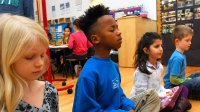8 Activities for Students (and Teachers) to Create a Mindful Classroom
Everyone in the classroom benefits when there are opportunities throughout the day to reflect and prepare for learning.
Your content has been saved!
Go to My Saved Content.The value of mindfulness-related activities in schools is not new. Writer and scientist helped legitimize the concept through his research, but its early connection to meditation raised red flags for some and kept its recommended practices from catching on. Now, however, as the adverse impact of stress on learning is quite well understood and the pandemic, along with racial and economic disparities, has escalated stress levels in schools worldwide, mindfulness practices are enjoying a resurgence.
I have had the opportunity to see many mindfulness practices in action in schools and to speak to a number of master teachers of mindfulness. I have identified eight activities that are relatively easy to implement in classrooms and schools. With a little practice, these can be part of any educator’s pedagogical toolbox.
Caring Openings
1. Silent 60: Start the class by having all students sit quietly for 60 seconds to get themselves ready for learning. You can add a focus on a particular sound in the room, an image you provide (e.g., a dot on a piece of paper, an abstract picture you put up on a screen), or their breathing. Start with 15 seconds for early elementary students and gradually increase. Begin with 20–30 seconds for upper elementary.
2. Powerful Listening: Ring a bell, use a wind chime, or employ another object that makes a long, trailing sound. Ask students to listen and raise their hands when they no longer can hear the sound. After all agree that the sound has stopped, set a timer for one minute, ask students to sit quietly, and then when time is up, ask them what they heard during that minute.
3. One Minute for Good: Start the class by having students reflect for a minute about something that has gone well or something that they are grateful for. This can be done in writing, pair shares, or small or large group discussions. Larger groups work best for early elementary.
4. Morning Classroom Conversations: Start the day with a quote that can stimulate short conversations to help middle and high school students begin to interact with classmates in supportive ways. Sample conversation prompts can be found .
In the Moment
5. Three Breaths: Have students take three deep breaths at regular intervals, such as before class changes or whenever strong feelings of anxiety or tension arise. Teachers should instruct students on this breathing technique and create visual reminders and prompting signals for students to begin. This is a valuable practice for staff as well, as expert mindfulness teacher Danielle Nuhfer, who has compiled an array of marvelous techniques in , shared with me:
“The great thing about Three Breaths is that if the teacher would like to share with students what he/she is doing, they can. I’ve been known to pause, put my hand on my chest/heart, tell my class that I need a moment, and take three breaths. This is something that is a great way to demonstrate our own emotional regulation. When students witness their teacher work through a stressful situation in a way that demonstrates awareness and presence, they may remember that themselves. Sometimes this kind of role modeling can be more impactful than even teaching a lesson to our students about emotional regulation.”
6. Body Scan: Educators benefit from learning to focus on their bodies. Make sure you are feeling centered with both feet on the floor as you teach your classes or meet with students or colleagues. Notice when and where you are feeling tension or when your breathing is shallow or labored, and use Three Breaths (or more!) to help you feel some relief. Don’t hesitate to let students or colleagues know that you are taking a few moments to gather yourself via breathing.
7. Speak Your Mantra: Develop a phrase that helps you keep focus and keep perspective. Repeat it often—when you encounter roadblocks and when things are going well. Put it in places where you will see it because when emotions run high, we can lose sight of our more cherished values. Some examples:
- “I am preparing all of these children for an uncertain future.”
- “I want all students to enjoy well-being, happiness, and peace.”
- “My goal is to prepare students for the tests of life—not just a life of tests.”
Ending the Day
8. Concluding Reflections: Many have extolled the value of reflection, from Sir John Templeton, founder of the character-focused foundation with his name, to the SEL exemplar . Mindfulness experts like Nuhfer have joined that group. Below are five of her favorites for closing the school day, plus two of my own:
- Something I learned today…
- I am curious about…
- I am looking forward to tomorrow because…
- Something I’ll do (next, later today, this weekend, before the end of the week, etc.)…
- A question I still have is…
- I had the best feeling today when…
- Something from today that I am grateful for/thankful for/appreciative of is…
Most teachers start off as teachers who use mindfulness; moving to become a “mindful teacher”—what Nuhfer describes as a teacher who “acts with awareness about what is happening in the moment,” at every moment—takes practice with multiple techniques, reading the relevant literature, being aware of implicit biases, and being part of a community of like-minded educators who help each other improve.
